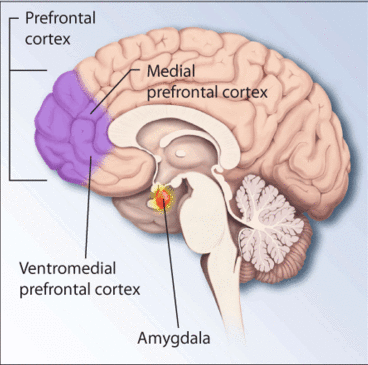|
Fear Potentiated Startle
Fear-potentiated startle (FPS) is a reflexive physiological reaction to a presented stimulus, and is an indicator of the fear reaction in an organism. The FPS response can be elicited in the face of any threatening stimulus (e.g., any object, person or situation that would cause someone to experience feelings of fear), but it can also be elicited by a neutral stimulus as a result of fear conditioning, a process that occurs when a benign stimulus comes to evoke fear and anxiety upon being paired with a traumatic or fear-provoking event. The stimulus in question is usually of auditory (e.g., loud noise) or visual (e.g., bright light) nature, and startle response measures include eyeblink rates and pulse/heart rate. The negative impact of heightened FPS in the face of neutral stimuli can be treated pharmacologically, using psychotropic medications that are typically used to reduce anxiety in humans. Recent literature, moreover, has implicated increased FPS responses as a correlate in po ... [...More Info...] [...Related Items...] OR: [Wikipedia] [Google] [Baidu] |
Fear Conditioning
Pavlovian fear conditioning is a behavioral paradigm in which organisms learn to predict aversive events. It is a form of learning in which an aversive stimulus (e.g. an electrical shock) is associated with a particular neutral context (e.g., a room) or neutral stimulus (e.g., a tone), resulting in the expression of fear responses to the originally neutral stimulus or context. This can be done by pairing the neutral stimulus with an aversive stimulus (e.g., an electric shock, loud noise, or unpleasant odor). Eventually, the neutral stimulus alone can elicit the state of fear. In the vocabulary of classical conditioning, the neutral stimulus or context is the "conditional stimulus" (CS), the aversive stimulus is the "unconditional stimulus" (US), and the fear is the "conditional response" (CR). Fear conditioning has been studied in numerous species, from snails to humans. In humans, conditioned fear is often measured with verbal report and galvanic skin response. In other animals ... [...More Info...] [...Related Items...] OR: [Wikipedia] [Google] [Baidu] |
Abuse
Abuse is the improper usage or treatment of a thing, often to unfairly or improperly gain benefit. Abuse can come in many forms, such as: physical or verbal maltreatment, injury, assault, violation, rape, unjust practices, crimes, or other types of aggression. To these descriptions, one can also add the Kantian notion of the wrongness of using another human being as means to an end rather than as ends in themselves. Some sources describe abuse as "socially constructed", which means there may be more or less recognition of the suffering of a victim at different times and societies. Types and contexts of abuse Abuse of authority Abuse of authority includes harassment, interference, pressure, and inappropriate requests or favors. Abuse of corpse :''See: Necrophilia'' Necrophilia involves possessing a physical attraction to dead bodies that may led to acting upon sexual urges. As corpses are dead and cannot give consent, any manipulation, removal of parts, mutilation, or se ... [...More Info...] [...Related Items...] OR: [Wikipedia] [Google] [Baidu] |
Depression (mood)
Depression is a mental state of low mood and aversion to activity, which affects more than 280 million people of all ages (about 3.5% of the global population). Classified medically as a mental and behavioral disorder, the experience of depression affects a person's thoughts, behavior, motivation, feelings, and sense of well-being. The core symptom of depression is said to be anhedonia, which refers to loss of interest or a loss of feeling of pleasure in certain activities that usually bring joy to people. Depressed mood is a symptom of some mood disorders such as major depressive disorder and dysthymia; it is a normal temporary reaction to life events, such as the loss of a loved one; and it is also a symptom of some physical diseases and a side effect of some drugs and medical treatments. It may feature sadness, difficulty in thinking and concentration and a significant increase or decrease in appetite and time spent sleeping. People experiencing depression may have ... [...More Info...] [...Related Items...] OR: [Wikipedia] [Google] [Baidu] |
Phobia
A phobia is an anxiety disorder defined by a persistent and excessive fear of an object or situation. Phobias typically result in a rapid onset of fear and are usually present for more than six months. Those affected go to great lengths to avoid the situation or object, to a degree greater than the actual danger posed. If the object or situation cannot be avoided, they experience significant distress. Other symptoms can include fainting, which may occur in blood or injury phobia, and panic attacks, often found in agoraphobia. Around 75% of those with phobias have multiple phobias. Phobias can be divided into specific phobias, social anxiety disorder, and agoraphobia. Specific phobias are further divided to include certain animals, natural environment, blood or injury, and particular situations. The most common are fear of spiders, fear of snakes, and fear of heights. Specific phobias may be caused by a negative experience with the object or situation in early childhood. Soci ... [...More Info...] [...Related Items...] OR: [Wikipedia] [Google] [Baidu] |
Stress (biology)
Stress, either physiological, biological or psychological, is an organism's response to a stressor such as an environmental condition. Stress is the body's method of reacting to a condition such as a threat, challenge or physical and psychological barrier. There are two hormones that an individual produces during a stressful situation, these are well known as adrenaline and cortisol. There are two kinds of stress hormone levels. Resting (basal) cortisol levels are normal everyday quantities that are essential for standard functioning. Reactive cortisol levels are increases in cortisol in response to stressors. Stimuli that alter an organism's environment are responded to by multiple systems in the body. In humans and most mammals, the autonomic nervous system and hypothalamic-pituitary-adrenal (HPA) axis are the two major systems that respond to stress. The sympathoadrenal medullary (SAM) axis may activate the fight-or-flight response through the sympathetic nervous system ... [...More Info...] [...Related Items...] OR: [Wikipedia] [Google] [Baidu] |
Flashback (psychology)
A flashback, or involuntary recurrent memory, is a psychological phenomenon in which an individual has a sudden, usually powerful, re-experiencing of a past experience or elements of a past experience. These experiences can be frightful, happy, sad, exciting, or any number of other emotions. The term is used particularly when the memory is recalled involuntarily, especially when it is so intense that the person "relives" the experience, and is unable to fully recognize it as memory of a past experience and not something that is happening in "real time". History Flashbacks are the "personal experiences that pop into your awareness, without any conscious, premeditated attempt to search and retrieve this memory". These experiences occasionally have little to no relation to the situation at hand. For those suffering post-traumatic stress disorder (PTSD), flashbacks can significantly disrupt everyday life. Memory is divided into voluntary (conscious) and involuntary (unconsciou ... [...More Info...] [...Related Items...] OR: [Wikipedia] [Google] [Baidu] |
Psychological Trauma
Psychological trauma, mental trauma or psychotrauma is an emotional response to a distressing event or series of events, such as accidents, rape, or natural disasters. Reactions such as psychological shock and psychological denial are typical. Longer-term reactions include unpredictable emotions, flashbacks, difficulties with interpersonal relationships and sometimes physical symptoms including headaches or nausea. Trauma is not the same as mental distress or suffering, both of which are universal human experiences. Given that subjective experiences differ between individuals, people will react to similar events differently. In other words, not all people who experience a potentially traumatic event will actually become psychologically traumatized (although they may be distressed and experience suffering). Some people will develop post-traumatic stress disorder (PTSD) after being exposed to a major traumatic event (or series of events). This discrepancy in risk rate can be ... [...More Info...] [...Related Items...] OR: [Wikipedia] [Google] [Baidu] |
Journal Of Traumatic Stress
The ''Journal of Traumatic Stress'' (JTS) is a peer-reviewed academic journal published bimonthly by Wiley-Blackwell on behalf of the International Society for Traumatic Stress Studies. the editor-in-chief is Patricia K Kerig (University of Utah). The journal covers research on the biopsychosocial aspects of trauma and publishes original articles, brief reports, reviews, commentaries, and special issues devoted to single topics. According to the ''Journal Citation Reports'', the journal has a 2011 impact factor The impact factor (IF) or journal impact factor (JIF) of an academic journal is a scientometric index calculated by Clarivate that reflects the yearly mean number of citations of articles published in the last two years in a given journal, as i ... of 2.721, ranking it 22nd out of 109 journals in the category "Psychology, Clinical" and 32nd out of 117 journals in the category "Psychiatry (Social Science)". References External links * {{Official, http://onlinelibrar ... [...More Info...] [...Related Items...] OR: [Wikipedia] [Google] [Baidu] |
Variance
In probability theory and statistics, variance is the expectation of the squared deviation of a random variable from its population mean or sample mean. Variance is a measure of dispersion, meaning it is a measure of how far a set of numbers is spread out from their average value. Variance has a central role in statistics, where some ideas that use it include descriptive statistics, statistical inference, hypothesis testing, goodness of fit, and Monte Carlo sampling. Variance is an important tool in the sciences, where statistical analysis of data is common. The variance is the square of the standard deviation, the second central moment of a distribution, and the covariance of the random variable with itself, and it is often represented by \sigma^2, s^2, \operatorname(X), V(X), or \mathbb(X). An advantage of variance as a measure of dispersion is that it is more amenable to algebraic manipulation than other measures of dispersion such as the expected absolute deviation; for e ... [...More Info...] [...Related Items...] OR: [Wikipedia] [Google] [Baidu] |
Electromyography
Electromyography (EMG) is a technique for evaluating and recording the electrical activity produced by skeletal muscles. EMG is performed using an instrument called an electromyograph to produce a record called an electromyogram. An electromyograph detects the electric potential generated by muscle cells when these cells are electrically or neurologically activated. The signals can be analyzed to detect abnormalities, activation level, or recruitment order, or to analyze the biomechanics of human or animal movement. Needle EMG is an electrodiagnostic medicine technique commonly used by neurologists. Surface EMG is a non-medical procedure used to assess muscle activation by several professionals, including physiotherapists, kinesiologists and biomedical engineers. In Computer Science, EMG is also used as middleware in gesture recognition towards allowing the input of physical action to a computer as a form of human-computer interaction. Clinical uses EMG testing has a variety of ... [...More Info...] [...Related Items...] OR: [Wikipedia] [Google] [Baidu] |





